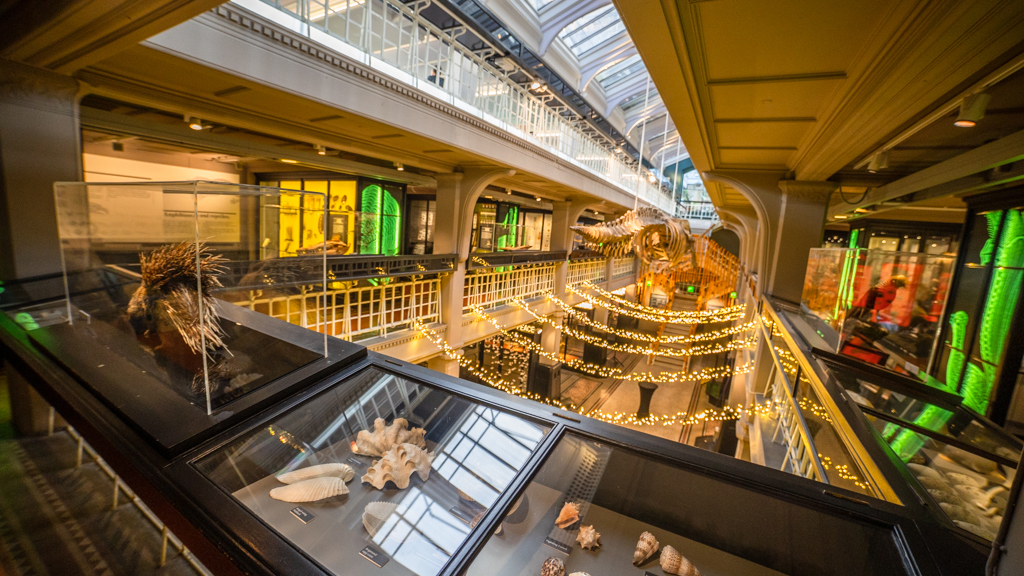Manchester Museum reopens after £15m redevelopment

Manchester Museum reopens this weekend following a £15m redevelopment that includes revamped galleries, a large temporary exhibition space and a new entrance.
The institution, one of the UK’s largest university museums, holds about 4.5 million objects. Its original neo-gothic building was designed by architect Alfred Waterhouse, who also designed London’s Natural History Museum.
Esme Ward, the director of Manchester Museum, said: “We have extended the building, making room for more joy and learning and evolving into the museum that Manchester needs. Beautiful new galleries and exhibitions will showcase the best of the museum’s historic collections, as well as addressing the urgencies of the present day and highlighting the complexities of our world.
“We have also listened to advocates with lived experience, and inclusive new spaces and features are incorporated throughout.”

The museum’s opening temporary exhibition is Golden Mummies of Egypt, which explores beliefs about the afterlife during the relatively little-known Graeco-Roman period of Egyptian history. The show runs until the end of the year and has been touring the US and China.
Manchester Museum has a strong collection from the Graeco-Roman period, excavated in the 19th century by Egyptian teams directed by Victorian archaeologist William Matthew Flinders Petrie.
The new permanent galleries include South Asia Gallery (see below), a partnership with the British Museum; a Lee Kai Hung Chinese Culture Gallery; the Belonging Gallery; and a Dinosaur display.
The Belonging Gallery has been curated by Alexandra P. Alberda, the first curator of Indigenous perspectives at Manchester Museum. She was appointed to take forward the Indigenising Manchester Museum programme, which is funded by the John Ellerman Foundation and sets Indigenous perspectives at the heart of the organisation.
Alberda is also undertaking provenance research with “source and diaspora communities” as part of the museum’s proactive approach to repatriation.
Manchester Museum has been developing a new approach to restitution, and has a policy of unconditional repatriation of objects that are sacred to communities of origin. The organisation, which follows the advice of the UN Declaration on the Rights of Indigenous Peoples, returned 43 objects to various indigenous communities in Australia in 2019.
The redevelopment of Manchester Museum has been supported by Arts Council England, the National Lottery Heritage Fund, the University of Manchester, and many philanthropic supporters. The architect for the scheme was Purcell.

South Asia Gallery
The South Asia Gallery at Manchester Museum, a partnership with the British Museum, has been co-curated by the South Asia Gallery Collective, a group of 30 people, including community leaders, educators, artists, historians, journalists and musicians.
The gallery showcases more than 140 historic artefacts from the collections of the Manchester Museum and British Museum, alongside new contemporary commissions and personal objects provided by the collective.
Nusrat Ahmed, South Asia Gallery curator at Manchester Museum, said: “The co-curated South Asia Gallery envisages a collaborative, iterative space that will generate new perspectives and connections. We hope to engage further diaspora communities on its opening and support its continual evolution. This personalised approach humanises the gallery, telling stories about real people and their objects.”
The gallery’s story-led design reflects multiple voices and perspectives on South Asia through six overarching themes: Past & Present, Lived Environments, Science & Innovation, Sound, Music & Dance, British Asian, and Movement & Empire.
Nazma Noor, who works in digital marketing in the arts, was one of the South Asia Gallery Collective.
“There was lots of learning and it was all pretty new,” said Noor, who was involved in creating the Past & Present section of the gallery. “But it was a very consultative process and I’m really happy that we were able to collaborate and be involved in things.
“There was a massive group of us and in the early days there were lots of big ideas and discussions and it was through those discussions that things slowly became clearer.”
The South Asia Gallery is one of a number of Partnership Galleries that the British Museum has with other organisations, including Kelvingrove Art Gallery and Museum in Glasgow and the Royal Cornwall Museum in Truro.
“It was very demanding for the 30 individuals in the South Asia Gallery Collective who had to figure out together what this gallery was going to be,” said British Museum director Hartwig Fischer. “That in itself was like a process of community building.
“They had lots of decision-making power but were also keen to work with the curators. So what you see has grown out of that dynamic as a collective, working with curators but also architects and graphic designers to produce what I think is a very beautiful, inspiring and thought-provoking gallery.”
